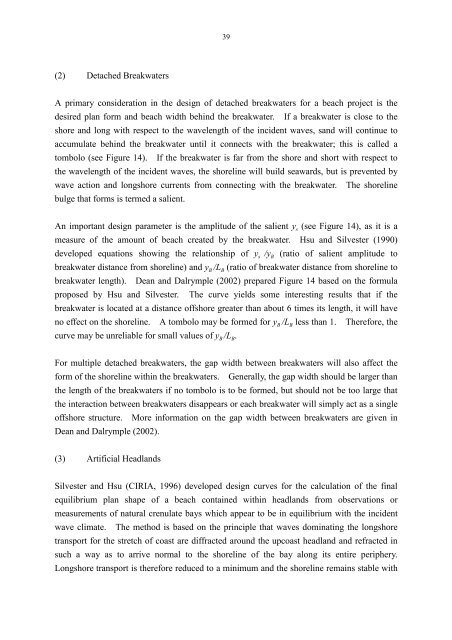PORT WORKS DESIGN MANUAL PART 5 Guide to Design of ...
PORT WORKS DESIGN MANUAL PART 5 Guide to Design of ...
PORT WORKS DESIGN MANUAL PART 5 Guide to Design of ...
Create successful ePaper yourself
Turn your PDF publications into a flip-book with our unique Google optimized e-Paper software.
39<br />
(2) Detached Breakwaters<br />
A primary consideration in the design <strong>of</strong> detached breakwaters for a beach project is the<br />
desired plan form and beach width behind the breakwater. If a breakwater is close <strong>to</strong> the<br />
shore and long with respect <strong>to</strong> the wavelength <strong>of</strong> the incident waves, sand will continue <strong>to</strong><br />
accumulate behind the breakwater until it connects with the breakwater; this is called a<br />
<strong>to</strong>mbolo (see Figure 14). If the breakwater is far from the shore and short with respect <strong>to</strong><br />
the wavelength <strong>of</strong> the incident waves, the shoreline will build seawards, but is prevented by<br />
wave action and longshore currents from connecting with the breakwater. The shoreline<br />
bulge that forms is termed a salient.<br />
An important design parameter is the amplitude <strong>of</strong> the salient y s (see Figure 14), as it is a<br />
measure <strong>of</strong> the amount <strong>of</strong> beach created by the breakwater. Hsu and Silvester (1990)<br />
developed equations showing the relationship <strong>of</strong> y s /y B (ratio <strong>of</strong> salient amplitude <strong>to</strong><br />
breakwater distance from shoreline) and y B /L B (ratio <strong>of</strong> breakwater distance from shoreline <strong>to</strong><br />
breakwater length). Dean and Dalrymple (2002) prepared Figure 14 based on the formula<br />
proposed by Hsu and Silvester. The curve yields some interesting results that if the<br />
breakwater is located at a distance <strong>of</strong>fshore greater than about 6 times its length, it will have<br />
no effect on the shoreline. A <strong>to</strong>mbolo may be formed for y B /L B less than 1. Therefore, the<br />
curve may be unreliable for small values <strong>of</strong> y B /L B .<br />
For multiple detached breakwaters, the gap width between breakwaters will also affect the<br />
form <strong>of</strong> the shoreline within the breakwaters. Generally, the gap width should be larger than<br />
the length <strong>of</strong> the breakwaters if no <strong>to</strong>mbolo is <strong>to</strong> be formed, but should not be <strong>to</strong>o large that<br />
the interaction between breakwaters disappears or each breakwater will simply act as a single<br />
<strong>of</strong>fshore structure. More information on the gap width between breakwaters are given in<br />
Dean and Dalrymple (2002).<br />
(3) Artificial Headlands<br />
Silvester and Hsu (CIRIA, 1996) developed design curves for the calculation <strong>of</strong> the final<br />
equilibrium plan shape <strong>of</strong> a beach contained within headlands from observations or<br />
measurements <strong>of</strong> natural crenulate bays which appear <strong>to</strong> be in equilibrium with the incident<br />
wave climate. The method is based on the principle that waves dominating the longshore<br />
transport for the stretch <strong>of</strong> coast are diffracted around the upcoast headland and refracted in<br />
such a way as <strong>to</strong> arrive normal <strong>to</strong> the shoreline <strong>of</strong> the bay along its entire periphery.<br />
Longshore transport is therefore reduced <strong>to</strong> a minimum and the shoreline remains stable with

















